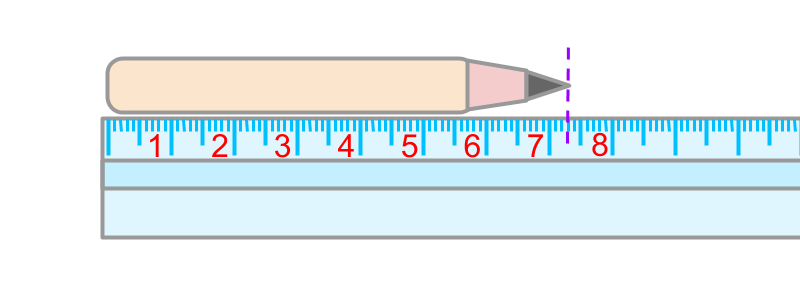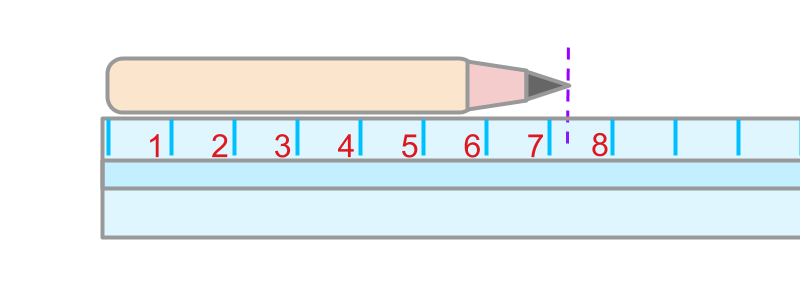
what you'll learn...
overview
In this page, approximation of a number to the nearest "degree of approximation" is explained with a practical example.
In many applications, the value of measurement or count need not be accurate. It can be approximated or estimated to the nearest value to some degree.
Accurate and Approximate
The word "accurate" means:
The word "approximate" means:

The accurate length of the pencil in the figure is 7373mm.

Let us consider a scale that does not have graduated marks for millimeters. Using the scale, the accurate length cannot be measured. The approximate length of the pencil in the figure is 77 centimeter. Note that the value 77 is closer to the accurate length.
Estimation

The accurate length of the pencil in the figure is 7878mm.

Considering the scale with only centimeter marks, the approximate length of the pencil is measured as 88 centimeter. Note that the value 88 is closer to the accurate length.
In many applications, the value of measurement or count need not be accurate. It can be approximated to the nearest value to some degree.
The degree of approximation is explained as follows
• 3842 approximated to nearest 10 is 3840. The degree of approximation is to the nearest 10.
• 3842 approximated to nearest 100 is 3800. The degree of approximation is to the nearest 100.
• 3842 approximated to nearest 1000 is 4000. The degree of approximation is to the nearest 1000.
The word "degree" means amount or level to which something is present. Degree of approximation is the level to which something is approximated.
The word "estimation" means: approximation and rough calculation to the nearest value. The estimation of a count or measure is the approximate value of the count or measure.
Approximation of numbers : A number may be approximated or rounded to the nearest 10, or 100, or 1000, etc. If the number is halfway or above, then it is approximated to the higher value. If not, then it is approximated to the lower value.
Examples
The approximate value of 3428 to the nearest 100 is 3400.
Estimate the value of 428 to the nearest 10 : The value of 428 to the nearest 10 is 430.
The approximate value of 3450 to the nearest 100 is 3500.
Summary
Approximation of numbers : A number may be approximated or rounded to the nearest 10, or 100, or 1000, etc. If the number is halfway or above, then it is approximated to the higher value. If not, then it is approximated to the lower value.
The degree of approximation is explained as follows
• 3842 approximated to nearest 10 is 3840. The degree of approximation is to the nearest 10.
• 3848 approximated to nearest 10 is 3850. The degree of approximation is to the nearest 10.
• 3842 approximated to nearest 100 is 3800. The degree of approximation is to the nearest 100.
• 3842 approximated to nearest 1000 is 4000. The degree of approximation is to the nearest 1000.
Outline
The outline of material to learn whole numbers is as follows
Note: click here for detailed outline of Whole numbers
• Introduction
→ Numbers
→ Large Numbers
→ Expanded form
→ Face and place values
→ Approximation and Estimation
• Comparison
→ Comparing two numbers
→ Number line
→ Predecessor & Successor
→ Largest & Smallest
→ Ascending & Descending
• Addition Subtraction
→ Addtion: First Principles
→ Addition: Simplified Procedure
→ Subtraction: First Principles
→ Subtraction: Simplified Procedure
• Multiplication Division
→ Multiplication: First Principles
→ Multiplication: Simplified Procedure
→ Division: First Principles
→ Division: Simplified Procedure
• Numerical Expression
→ Introducing Numerical Expressions
→ Precedence
→ Sequence
→ Brackets